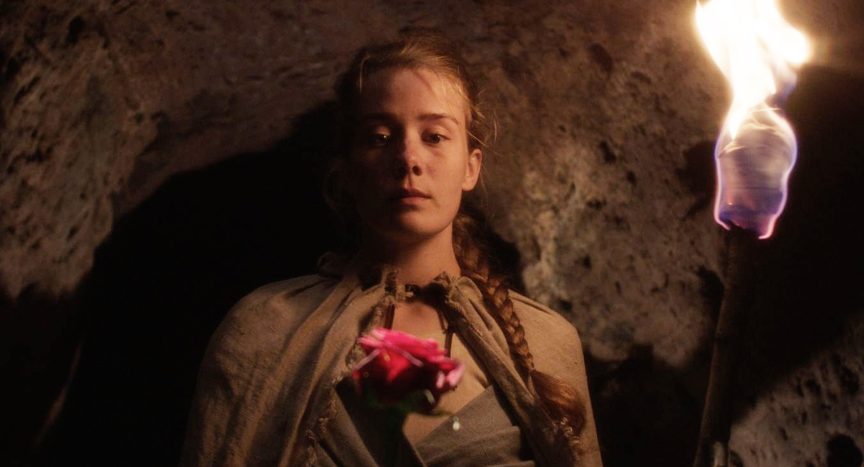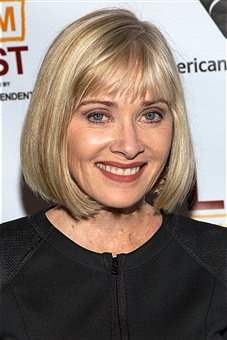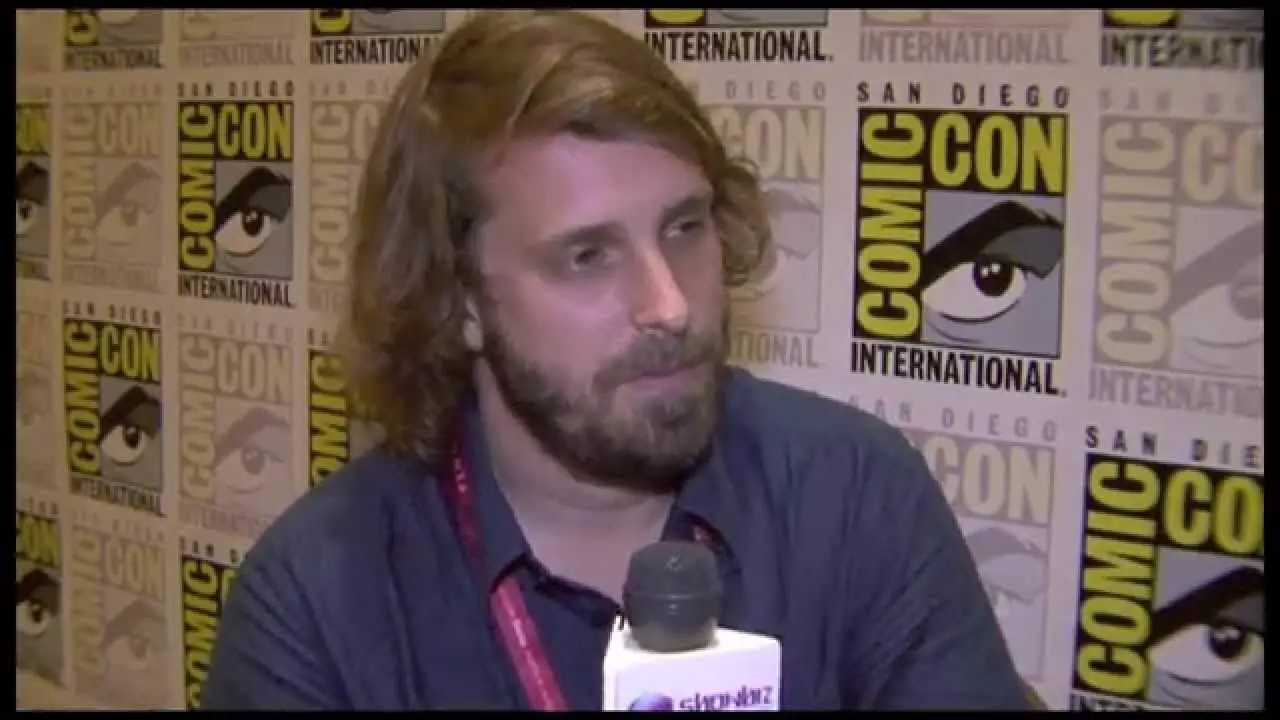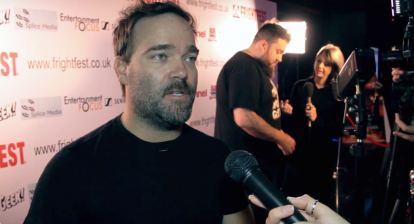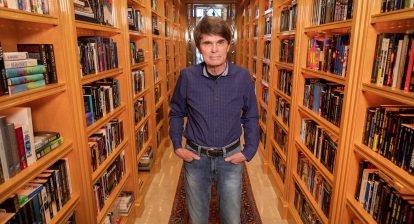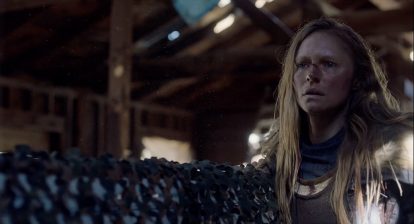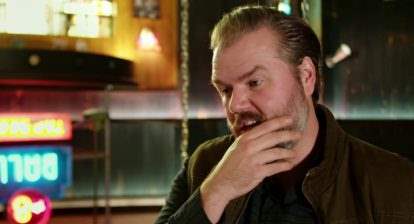Most people are familiar with Disney’s Beauty and the Beast films, whether it be the animated or live action versions. Level 33 Entertainment is now answering the question of what a live action, horror-fantasy version of that story would look like with Belle. Directed by Max Gold, the feature follows the titular character, who works on the family farm and cares for her father after he falls severely ill. Desperate to save him, she journeys in search of a mythical rose believed to be a cure. She must surrender herself as a prisoner to a vicious beast as payment for the rose. Battling the beast’s spell and the two toxic relationships in her life, Belle’s true journey is only just beginning.
Belle was shot completely in Iceland, so when it came time for the composer, Matt Orenstein, to begin crafting music, many questions arose. One of them being, how would Matt bring warmth to some of the more tender love scenes, as the icy tundra backdrop invades the screen. Matt, whose other credits include Gongoli, Earth Over Earth, and Silicon Beach answers that question and much more in the below interview.
Wicked Horror: You worked on the Belle score for an entire year. What was the first thing you did and what was the last thing you did?
Matt Orenstein: The first thing I always do is watch the cut from start to finish, taking notes, making a spotting spreadsheet that lists the timecode, the source of the temp music and its BPM, along with any other notes about the music or the scene. I also make special notes of any repeating temp. This way I can get a bird’s eye view of how the score should evolve with the film, and what kinds of sounds we all respond to. Then I start writing music for the moment where I have the clearest idea. Ironically, the moment I picked, the one where Belle is riding to Beast’s cave, took about twenty revisions to get right, so my idea was clear, but not right. That’s a lot of revisions for anything, but both director Max Gold and I were determined to nail it and we weren’t going to settle for something that didn’t work. The last thing I did was I wrote the end credits suite, which contains most of the themes in the movie. Which also essentially gives you a bird’s eye view of the score.
Wicked Horror: You have mentioned that Mark Korven’s The Witch score was a big inspiration for the Belle score. Can you talk about what it is about The Witch score that resonated so well with you?
Matt Orenstein: My favorite scores are the ones that seem like they come from within the world of the film. Blade Runner is maybe the best example, and my favorite film score ever, but The Witch is a close second. The more melodic parts not only effectively underscore the bleak hardness of the main family’s existence, but they sound like they’re contemporary to the story itself. Korven mostly uses period instruments; nyckelharpes, baroque cello, viol, hurdy gurdy, etc. In the horrific moments, he uses the same tools to create a sense of something unknown, volatile, and evil. The musical language he created not only as room for these bigger, more general impressions you get from the movie, but there’s room to reflect the tonal nuances. Nothing he writes is sentimental, nothing he writes conveys any sense of hope. Just like the story itself. There’s an unadorned, claustrophobic quality to the sound palate that also works well with the film. Seeing it in the theater and hearing the score together made for a totally immersive experience that ended with me screaming at the jump scares. My friend Rachel, who I saw it with, will never let me live it down.

Wicked Horror: Did you learn anything in particular from working on Belle?
Matt Orenstein: I learned a lot about how to stay organized on a project of this scope. This wasn’t my first feature, but it was the only one I’ve done entirely remotely, and had the most music to write (65 minutes in the movie total). So the things I had done to stay organized on other films only took me so far on this one. I’ve done features with less music due since then, and the strategies I developed on Belle have helped me be more efficient on these other films. From a music tech standpoint, this was my first time really working with Kontakt (I had used the EastWest Play player for other scores), and my first time building sample instruments in Logic, both of which I’ve used extensively since Belle. I also learned to be more attuned to the cut itself, and some strategies for giving the edit an assist. With every project, I think I have a better idea of how to watch a film as someone working on it, and what kinds of questions to ask the director and editor to make sure that I’m offering the right kind of support.
Wicked Horror: What is key to breaking out of a formulaic horror score and surprising audiences?
Matt Orenstein: I don’t know if I have the key to anything. It does seem like, though, that if you can get a good read on the emotional underpinnings of the script, get to know the characters and figure out exactly where the horror is, that’s the most important step. Instruments, ensembles, musical ideas, and sound textures have associations with them, so it’s important to get on the same page with the director about how certain sounds make them feel, and if they remind them of anything. And be honest with yourself about the same. Working closely with the editor and sound design never hurts either, so between the director and those two you can figure out how to technically structure your scares and build suspense. I never felt like we were working on anything formulaic with Belle because I felt like when it came to score, we were working closely with the film above all else. And Belle isn’t formulaic.
Wicked Horror: There is a scene when the Beast is sitting at the table screaming and looking at his hands. How did you decide the volume level the score would be here? You could have raised the score level to create more emotion, but you chose to let the Beast take over. Why?
Matt Orenstein: What a great question! I don’t think the score needed to tell you anything beyond what you get from Ingi’s powerful performance. The scream is the most important sound in the scene. The more score-forward moments in the film are places where we wanted to create an atmosphere, or foreground something about a character, but for this particular moment, the Beast is wrestling with his guilt and frustration in such a real and raw way that we didn’t need that much of an assist from me. My goals for this cue as a whole were to create some sense of anticipation and dread, and carry it over into shading the deep anguish Beast feels in this moment after we see what he’s done and why.

Wicked Horror: Can you point to the most complicated scene for you to film? Why was it so difficult?
Matt Orenstein: The most complicated scene to score? Probably when Belle first meets Beast and gets the rose from him. There were so many things that we wanted score to help convey: Belle is in the presence of magic, first of all. She could be in some serious danger, so there’s suspense we have to convey. And then there’s the reveal of Beast as a handsome man … it took us a while to land on a piece of music that conveyed that Beast was a sexy, dangerous man. I wound up reverse engineering the music from a few cues I had written that show up later in the movie, a motif for when there are sparks flying between Belle and Beast. And then we need to carry the atmosphere of sex, magic, and danger throughout the scene, which meant working closely with Max and Patrick Lawrence, our editor, to make sure that the score was supporting the cut in a way that worked.
Wicked Horror: Can you talk about Belle’s theme. What did you want that particular music to convey?
Matt Orenstein: Belle’s theme is another one that took some time to get right, since there was a particular feeling Max had in his mind. We knew we wanted it to play when Belle is in these sort of moments-between-moments, when she’s not being called by Papa to do something errand or chore, when she’s not interacting with Beast, or she’s taking a moment to herself. The original title of this movie was Fanga, which is Icelandic for prisoner … so Belle’s theme would occur in the moments where she didn’t feel like a prisoner to either Beast or Papa. When we added in the voiceover of her Mom, Belle’s theme also became about grief. Functionally, though, we wanted the theme to feel like a tune stuck in her head. So the challenge was coming up with something catchy, but that could convey Belle’s inner experience with finesse.
I didn’t write Belle’s theme until I had written everything else. After I had done some drafts the Icelandic actress who plays Belle, Andrea Snædal, sent us some examples of melodies she thought best conveyed an Icelandic melodic sensibility. So I spent some time with those, and came up with something in that vein. How I harmonize the theme at different points depends on what’s going on in the film.
Wicked Horror: You visited Iceland, where Belle was filmed, to get better sense of the film. Did your idea of what you wanted the score to sound like change at all after the visit?
Matt Orenstein: I didn’t go into my Iceland trip with any concrete ideas, just a few exploratory conversations with Max. He liked a lot of the soundscapes and the overall shape of Koji Kondo’s Legend of Zelda: Ocarina of Time score, and I had a couple Icelandic musicians that I admired that I was curious about using as a jumping off point. Bjork and Johann Johansson were who I had in mind. After my trip I didn’t have any cohesive ideas either, just a few sounds and elements kicking around.
For starters, I knew I wanted raw, strident female vocals like the Bulgarian Women’s Choir, or Bjork’s Medulla album. I also wanted some bigger orchestral textures that I felt could reflect the landscape. I wanted to shy away from synths, except to create wind sounds, since the wind is the most common sound in the natural soundscape as it turns out. As we worked, though, and the shape of what we were making started to crystallize, my ideas changed. For example early on, Max encouraged me to bring the synths into the fold, since we used them a lot to great effect in some of our other collaborations. He was right. They’re just tools, and I could use them in a way that fit Belle. The big challenge was to let go of the Iceland that we saw, since that wasn’t quite what we were showing. We were creating a fantasy world. So we could use our experience there as a basis for how we wanted the score to feel, but we had to figure out how to create something that felt more distinct.
Wicked Horror: Why do you think horror fans will like Belle?
Matt Orenstein: The sense I get is that some of my favorite horror uses the horrific to convey something basic that people can relate to, and that’s what I think we did with Belle. The Babadook deals with grief. Candyman deals with generational trauma (and how it can be especially overwhelming as our past gets erased). You could make a solid case that some of the scariest parts of The Exorcist are the prospects of Chris O’Neill losing her child to something so horrible, and of Regan losing herself. Cynthia Pelayo’s Children of Chicago, one of the scariest books I’ve ever read, is something I read as having to do with guilt, and our worst mistakes following us. Belle uses Beauty and the Beast and horror as a vehicle for talking about love, addiction, toxic relationships, what we owe and who we owe it to. And the cost of our survival.
That, and you get to see the Beast eat some people, so that’s fun.
If you like darker Beauty and the Beast stories, here are some more you might like.

